
|   |

|   |
Australian Diary: Part 2 Interview with Kathakali and Mohiniattam dancer Tara Rajkumar - Dr. Sunil Kothari e-mail: sunilkothari1933@gmail.com Pics courtesy: Tara Rajkumar's Archives August 17, 2009 Australian Diary: Part 1 Interview with Kathakali and Mohiniattam dancer Tara Rajkumar (This is the second part of an extensive interview and deals with Tara Rajkumar's work in Melbourne. Part 1 dealt with her work in London) Sunil Kothari: You were at the height of your professional career as a dancer in UK. I understand you left in the early 1980s for Australia. Tara Rajkumar: Rajkumar was invited to join as Senior Research Scientist in 1982, in one of the renowned firms in Sydney. I moved to Australia in 1983. It is great to see the wonderful work being done and recognition achieved for South Asian dance by the Akademi, as it is now called, in London. 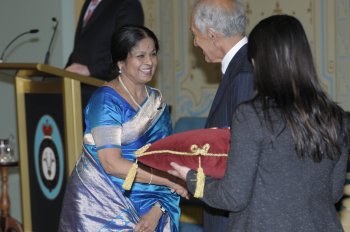  I toured my Natya Sudha Dance Company's production, Temple to Theatre, in the UK at the invitation of the Academy with Arts Council of Great Britain's support in 1993 and it was so satisfying to see that the Academy had already made great strides and achieved further national recognition in South Asian dance by then. Our performances in that exciting tour were at The Place Theatre, Bharatiya Vidya Bhavan and the Theatre Museum Covent Garden in London, and Brantford, Milton Keynes, Birmingham, Swindon, Bristol, Leicester in the regions. The response we received was wonderful and it was so heartwarming to know that I was still remembered and with some affection in the UK! Our performance at the Bhavan moved the well known dance critic, Jane King, to remark in her review in the Dancing Times of June 1993 that, “after an absence of eight years spent pioneering the art of Indian dance in Australia, Tara Rajkumar, Founder-Director of our own Academy of Indian Dance, returned in triumph, for one night only with her production From Temple to Theatre, to the Bharatiya Vidya Bhavan in West Kensington.” This was the venue where I was still remembered with particular affection for the beautiful mime and dramatic expression of my performances, and for teaching. Now that I had returned to Melbourne where I was Artistic Director of Artslinks of the Commission for the Future, a Fellow of the Music Department of Monash University, she said that in spite of all these responsibilities, I should not keep away for so long, I must visit all my friends and admirers, in the United Kingdom. I felt very elated. SK: After you moved to Melbourne in 1983, how did you start your career as a dancer, choreographer and when did you establish Natya Sudha? TR: Natya Sudha was established in 1986, after three years. By the time I arrived in Melbourne, I was sufficiently well known as an established dancer. So I began slowly but on a sound footing. Of course in the beginning I did miss London and the activities but soon in Melbourne, I was able to receive support from many people interested in arts. And of course my husband Rajkumar helps me a lot. During my stay with Tara and Rajkumar, I visited Tara's school, studio and also watched the classes she runs at her residence. It was interesting to see how Tara conducts her classes. I asked her about her training methodology, on how Indian Diaspora tackles this art of transmitting technique of classical dance forms. SK: How do you start teaching young kids? Do you start teaching them with a prayer? Then Hastas/shlokas? Viniyogas? Do you follow Hastalakshanadipika? TR: I follow the traditional training methods, handed down to me by my gurus, the late Kalamandalam Krishnan Nair in Kathakali and Kalyanikutty Amma in Mohiniattam - they are adhered to for the classical dance styles. It starts with i) Namaskaram, ii) Kalsadhakam (footwork), iii) Meyyadakkam and Chuzhippu (exercises), iv) Kannusadhakam (eye exercises), v) Abhinaya - practice and preparation for facial expressions and Hastalakshanadipika (gestural language) are followed by advanced training. SK: What about the Mohiniattam repertoire? TR: The basic repertoire I teach in Mohiniattam generally includes Cholkettu (three variations in different talams and ragas), Jathiswaram in two different ragas, Padavarnam (at least one) Ramashabdam, Padams, one major Keerthanam / composition, Dashavataram, Thillana (at least one). The repertoire which I have developed through original choreography is now quite extensive and students have a large choice of items for specialization as they undergo the course. SK: How long is the course? TR: The course on average takes six years to complete. SK: Do you conduct the classes held at Mangala on Saturdays and Sundays? For the whole day? And how many batches do you have? What is the total number of students now? TR: Classes are held at Mangala Studios in Carlton on Sundays for the whole day with six batches of students. The core group of students is about 70; this does not include my students at Erasmus School. SK: How many days at home? TR: I teach on three days - Mondays, Wednesdays and Thursdays - at my home studio in Dingley and also hold special rehearsals and Arangetram training on other days on a reasonably regular basis. It is busy! 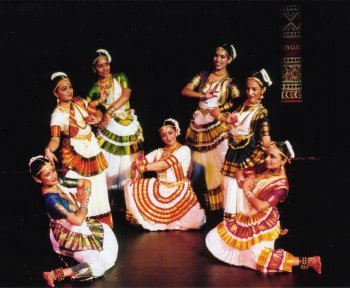 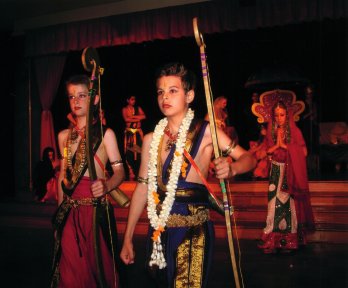 SK: Which is the institution where you teach Kathakali to drama students? When? TR: Erasmus School, Hawthorn. Erasmus School is part of a worldwide family of schools. At the heart of the school's curriculum is a belief that a good education leads one to truth and fulfillment. The school teaches a Philosophy of Unity. The curriculum is inspired by classical works of art, music and literature. Latin and Sanskrit are study options in the curriculum. Erasmus School was established in 1996 and now has 125 primary school pupils. It is governed and staffed by members of the School of Philosophy, Melbourne. It is quite an exciting environment for young children. I teach Kathakali on Tuesdays during school term. I choreographed the whole school's student performance of Ramayana in December 2005. I also included the Erasmus pupils in the story of Ramayana in my Deeparchana program at the BMW Edge Theatre, Melbourne in 2007. It was very satisfying that these productions involving the young children were highly appreciated. SK: How did you chance upon the Louise Lightfoot collection? TR: Monash University recognized my contributions to dance and dance education and the Arts in Australia and appointed me as an Honorary Fellow in the Department of Music. This was indeed a great honour. Louise Lightfoot had donated all of her archival material to the Music Department which was stored in the Department. Until I opened the trunk stored in the archives of Monash University's Music department all those years ago, Louise Lightfoot had been nothing more than a name to me. But once I began delving through its contents - the diaries, papers and artistic mementos - the spell was cast. I was so inspired by what I discovered from Lightfoot's mementoes that I created a dance theatre show about the life of this fascinating Australian expatriate. Premiered in both Australia and India, 'Temple Dreaming' interweaves Lightfoot's and my stories, two immigrants dedicated to maintaining the powerful, highly stylized form of Kathakali. SK: And how long did it take to choreograph? What was the main inspiration? And how did you work out the choreography with Australian dancers? And one who designs costumes for you… He played Sutradhar? TR: The main inspiration was the juxtaposition of Louise Lightfoot, an Australian lady, who went to India and became totally engrossed in Indian dance forms and myself who started in India and have taken Indian dance to the UK, Europe and Australia. The strong synergies, contrasts and intersections between our lives came out so strongly when I was researching for 'Temple Dreaming.' The archival material such as diary entries, costumes and even a Kathakali thiraseela (hand-held curtain) from Louise Lightfoot helped inspire me in the choreography. It was an exciting journey which took about one year to choreograph and present the premier in Melbourne in 1996. Several Australian dancers participated in the production with me. The choreography was challenging in the need to juxtapose western and Indian dancing and the move from traditional classical Kathakali and Mohiniattam through the martial arts of Kerala to contemporary dance sequences. The creative tensions in the choreography led to a great outcome! The production was premiered at the Alexander Theatre in Melbourne in 1996 during the launch of Monash University's Performing Arts Centre. This attracted an encouraging review in the issue of Sruti (June 1996) by Shobha Sekhar. I was so fortunate and privileged to have Brian Brown, the Head of Improvisation Studies at the Victorian College of the Arts, work with me. He set the music which complemented the imagery beautifully. The Carnatic classical music and the Western counterparts were brought together brilliantly. For Brian the real challenge was to integrate appropriate musical ideas in the Western idiom to suit the string rhythmic component, and the aesthetic and spiritual appeal of Indian dance. Even more challenging it was to set most parts to a fixed G scale of the Carnatic vocalist as opposed to the shifting of scales in the Western mode. Dr. Reis Flora, then at Monash University's Music Department, Professor Margaret Kartomi and Professor Marika Vicziany lent me their support and encouragement during this period. The Australia Council's Choreographic Fellowship Award and funding support for my work also helped immeasurably. The choreography and production were further refined for the successful tour to India in November-December 1997 on the occasion of the golden Jubilee of India's independence. I also expanded the collaboration and brought in the International Centre for Kathakali's artistes from Delhi for the tour. I was so happy that you witnessed the performance in Madras with Chandralekha, the Dhananjayans and many others from the dance fraternity. Mary Lightfoot, Louise Lightfoot's niece, also attended. The Sutradhar was Vernon Curtis, a great friend and an active member of the Natya Sudha Dance Company. Vernon is also an accomplished costume designer and maker. His costumes have featured in most of my productions including Temple Dreaming. In my current role as Fellow in the Monash Asia Institute, we have recently commenced the Louise Lightfoot Legacy Project initiative to strengthen links between India and Australia through the arts.  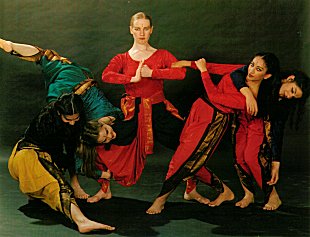 SK: What were the difficulties you had to face for the Delhi performance? I understand that it was very tough for you to arrange rehearsals and final presentation. TR: The tour to India was organized with international funding from the Australia Council and ICCR for travel and production costs with the local organizers in Delhi, Bangalore and Madras providing hospitality and accommodation. The arrangements made by our hosts in Bangalore and Madras were exceptionally good. But in Delhi, where the tour commenced, I landed with eight Australian artistes. On landing, the high profile head of the cultural institution rang me from the airport and told me that he was departing for a trip to the USA! I was also informed that a local Youth Hostel might put us up for at most a couple of days if we were interested! I had to spend the next precious days, which had been set aside for rehearsals with the International Centre for Kathakali, accessing and obtaining new sponsorship for accommodating the artistes in a decent hotel. The late Mr. Madhavan Kutty of the Mathrubhoomi newspaper lent kind help and support which got me out of a crisis. Without that help, Temple Dreaming would not have been staged in Delhi. The delays naturally held back the presentation to some extent in Delhi. But by then, we were fully up and running and triumphed in Bangalore and Madras, thanks to the great organizational back up provided there. SK: How has the Indian community been supporting you? Any prominent name you would like me to quote? TR: The Indian Community has been a great supporter of my work in Melbourne since 1984 when my first dance performance of Mohiniattam and Kathakali was organized. I had previously visited Melbourne under the auspices of Dance Umbrella when I was based in London. Incidentally I happened to be the first dancer from India to present a dance recital at the prestigious Victorian Arts Centre. The community here has been unwavering in its support of my work. Natya Sudha has contributed vigorously to cultural and dance programs for many Indian and Australian organisations here over the past two decades. The then Honorary Consul General for India in Melbourne Dr.Janardana Rao, Dr.Raman Marar, Dr.Martand Joshi, former Honorary Consul for India and many others have supported and encouraged my work over the past two decades. The Malayalee Association of Victoria, for example, instituted an Annual Encouragement Award for a student of the Natya Sudha School and several other community funded awards have been made. SK: How do you resolve problem of accompanying musicians? Who are local musicians? Indians settled in Melbourne, who support you? TR: We are extremely fortunate to have a wealth of musical talent in Melbourne, so the days of taped music for Mohiniattam are well and truly over! We are now able to mount full fledged arangetrams, annual concerts and company productions with live music. I have received great support from many high caliber classical Carnatic musicians who have also helped set new music for my productions. Vasumathi Subramanian and I go back over 20 years, her singing has accompanied my dancing and of my students. She has set the music for several dances in my extended Mohiniattam repertoire. Sridhar Chari on the mridangam, Murali Kumar and Narmatha Ravichandhira on the violin, Dr. Ramani's brother R Thiagarajan on the flute, Jayashree Ramachandran, have all participated in our programs. Indeed Shobha Sekhar and Ravichandhira, leading musicians here, accompanied me on our tour of Temple Dreaming to India in 1997. I must also mention that I have worked with several accomplished Australian/western musicians here particularly for my contemporary productions. For Kathakali, however, I have had to bring musicians from India because we don't have the expertise here. For example, Kalamandalam Unnikrishnan from the ICK in Delhi has come here on several occasions to accompany the musicians on the chenda. SK: I understand you presented your work in the prestigious Greenmill Dance Festival? TR: Sonal Mansingh and I performed at the Greenmill Dance Festival in 1996. We shared a program we called the Indian Double Bill. The first half was my solo performance of my contemporary choreography of Malache-Despatches from Another world, based on the book by Virginia Jane Rose which I had originally performed for the Arena Theatre production in 1994 at the Ceres African Village. The story was about a poor village woman with two daughters fighting with the bureaucrats to get a supply of water for her village. I used a mixture of English dialogue and contemporary dancing to convey the dire circumstances the family had to face including the death of one of the children. The second half of the program was Sonal's famous Draupadi including the spectacular disrobing scene of which you are well informed. SK: Tara, tell me more about your contemporary work on Australian themes. TR: My Natya Sudha Dance Company and I danced in several successful Indian classical dance productions of mine, like Mohini, the Divine Enchantress, Indian Dance Theatre, From Temple to Theatre, Natya Sudha to name a few, based on Mohiniattam and Kathakali in Australia and I also toured productions in New Zealand and the UK. I also invited the esteemed dancer and guru from ICK (Delhi), Sadanam Balakrishnan and we danced Bhasmasura-Mohini at the Malthouse to a great reception.   But it was in the 1990's that I began my journey into contemporary work. My contemporary productions include Krishna the Celestial Dancer (1994), Prakrithi (1997) a contemporary production highlighting the myths and legends which surround woman/goddess as Prakrithi (nature) which was interpreted through the poetry of the famous Australian poet Judith Wright. It was an honour to be invited to present this at the opening of the ASPACAE Conference in 1997 where I was also an invited keynote speaker. Then of course, Temple Dreaming, which was premiered in Melbourne (1996) and successfully toured in India (1997), brought together contemporary dance linking the traditional dance of Kathakali and Kalaripayattu, with modern contemporary dance. The music was composed, as I have mentioned earlier, by John Brown, then Director of Music at the Victorian College of the Arts and was performed by Western musicians. That was very novel indeed. I have already mentioned Malache-Despatches from Another World (1994 and 1997). Yes, and of course, I must mention about 'What She Said.' The famous Tamil poet Ramanujam's poetry was set to contemporary music and dance with English text and abstract visualization. The choreography was steered away from the traditional narrative technique of literal translation into dance. The subtle moods were captured through movement and abstract gesture in two sections: languid sleeplessness and anticipation in the first, and oppressive feelings caused by village gossip and separation in the second. This production was presented by invitation at the 9th World Sanskrit Conference and Orf100 International Conference in Melbourne.  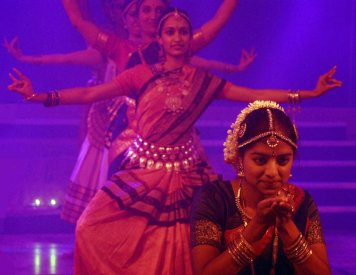 SK: That is very interesting, as in Chennai it was choreographed and staged by Gitanjali Kolanad, Anita Ratnam and Rajika Puri at the Museum Theatre. TR: I would also like to mention about Natya Treyi (Dance Trident) (2002) - a selection of my contemporary choreographic works which included Mary (based on a composition by my late father, TMB Nedungadi), Sun Yaar (in Punjabi), Kalari, Radha-Govinduni (based on a composition by Ariyarathne in Sinhalese) and scenes from my other works. SK: Tara, you showed me excerpts of your recent works. What are the similarities between Indian and Australian themes? At present what are you working upon? TR: Most of the above productions I have described have strong elements of the Australian Indian connections. The recent productions include 'Bhumi Taal' (2006); it traces the history of Australia and India, from ancient times when the two continents were joined as Gondwanaland to modern times when contemporary dance and Bollywood are bringing new links between the continents. This was performed for the Victorian Premier and the Victorian Multicultural Commission during the Commonwealth Games (2006) in Melbourne. 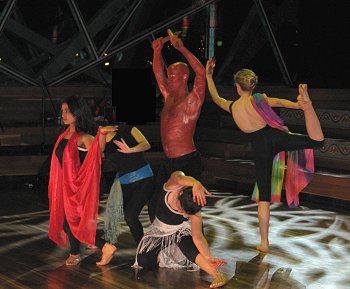 The latest is 'Kulin Bhumi' (2008). I have always been taken in and inspired by the great respect which indigenous Australians and we from India have for Mother Earth and the forces of nature. In this, in my most recent production, I have brought together elements of Indian dance traditions and Australian indigenous dance, through collaboration with dancer Jacob Boehme, to evoke the power of mother earth and nature. The pilot program was presented at the Fresh Dance New Beats event at the Victorian Arts Centre in June 2008. The interaction between indigenous and classical Indian dance is a stimulating experience for me and our Natya Sudha Dance Company dancers. I am sure this will evolve further as this inter-cultural work has deeper Australian and Indian sensibilities! SK: Thanks, Tara, I am glad we talked at leisure and I will be able to share all this with readers. It is important that your activities far away in Melbourne need to be known to the dance community. I wish you all the best. TR: Thanks, Sunil. I am sure we shall meet again when we start the Louise Lightfoot Legacy Project.  Dr. Sunil Kothari, dance historian, scholar, author, is a renowned dance critic, having written for The Times of India group of publications for more than 40 years. He is a regular contributor to Dance Magazine, New York. Dr. Kothari is a globetrotter, attending several national, international dance conferences and dance festivals. He has to his credit more than 14 definitive works on Indian classical dance forms. Kothari was a Fulbright Professor and has taught at the Dance Department, New York University; has lectured at several Universities in USA, UK, France, Australia, Indonesia and Japan. He has been Vice President of World Dance Alliance Asia Pacific (2000-2008) and is Vice President of World Dance Alliance Asia Pacific India chapter, based in New Delhi. A regular contributor to narthaki.com, Dr Kothari is honored by the President of India with the civil honor of Padma Shri and Sangeet Natak Akademi award. He recently received the Senior Critic award from Dance Critics Association, NYC. |